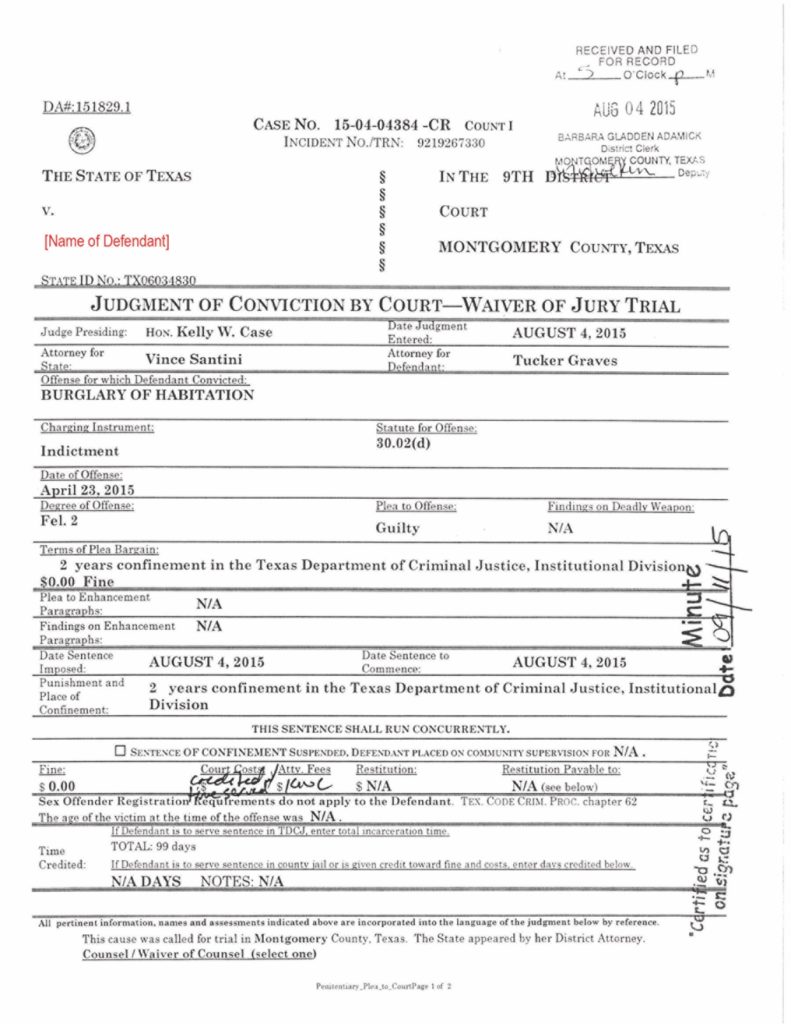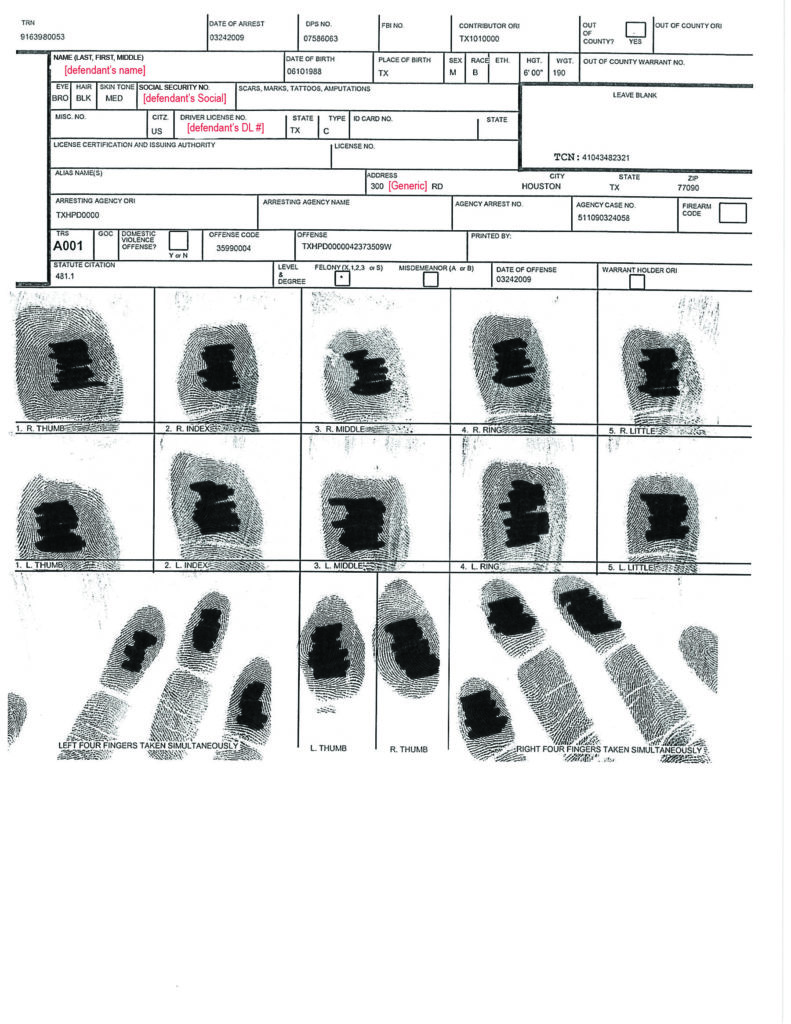Larry L. Melton
Wesley LeRouax
We all deal with “frequent flyers”—you know, those individuals who move in and out of the criminal justice system on a regular basis, seemingly for most of their adult lives. Maybe on probation here or parole there, but always back on the streets in a short time, ready to offend again. Much time and money is spent on these miscreants, not to mention the impact they have on their communities.
One of the tools prosecutors use to keep repeat offenders incarcerated longer is enhancing a sentence with a defendant’s prior convictions. Prosecutors must prove that certified judgments (proof of these prior convictions) belong to the defendant sitting in the courtroom, and fingerprints are a common way—though not the only way—of establishing that link. Oftentimes that one judgment from the 1970s can be the difference between a defendant facing two to 20 years in prison and 25 to life.
To get the judgments in front of the jury, we simply have to prove them relevant to the defendant for the judge to admit them. Once an expert testifies to the link between the defendant and the judgments, if the defense objects, prosecutors need only say, “Your Honor, that goes to the weight, not the admissibility, of the evidence.” The jury eventually has to believe the enhancement allegations beyond a reasonable doubt.
This article addresses how to establish the link between certified judgments and the defendant in court, both with and without fingerprints.
With fingerprints
When a defendant is arrested in Texas, it is normal procedure for his fingerprints to be taken sometime around booking. These fingerprints are transmitted to the Texas Department of Public Safety (DPS), where they are analyzed for electronic filing. If it is the first time DPS has received a defendant’s prints, that person is issued a unique State Identification (SID) number, which is assigned to him for the rest of his life. The SID is also listed on the fingerprint card as the DPS number. (Both numbers are the same.) Once a person has an SID number, he can be tracked throughout the criminal justice system, and the SID number is verified by fingerprints. No matter what alias or other false identifiers that person might provide in the future, his fingerprints will lead to his SID number and proper identifiers.
Some counties, such as Harris County (Houston), certify electronically using eGov. If you are fortunate enough to receive judgments with the fingerprints captured electronically, count your blessings. In most cases (though there are always exceptions), these prints exhibit better quality and resolution.
Each fingerprint submission is assigned a Tracking Number (TRN). If you have a subject’s TRN number, you can locate the specific electronic representation of the fingerprint card taken at booking. These cards (and prints) are filed in the CJIS Fingerprint Database maintained by DPS’s fingerprint division.
So, to summarize, having a defendant’s unique SID number can lead to a repository where his previous arrests are documented by a fingerprint card. Each card will have its own TRN number, each related to a specific arrest.
But what about making an identification when a legible fingerprint is missing from a judgment? Frankly, using alternate identification is not always successful. As many readers of this article know, judgments from days of old (and sometimes days of young) don’t always contain a plethora of information about the defendant himself, other than his name, cause number, date of the judgment, and date of the offense. (There’s an example of one on page 49.) Not much to go on, but that is sufficient to begin the search. You will first need to locate a fingerprint expert who has access to the DPS CJIS Archive Database. Again, this is the repository for all fingerprint cards taken during arrests in Texas. You can locate a person’s SID number by running a criminal history; the SID number will also give you access to each fingerprint card.
Which brings us to the most important step in the identification process. The defendant’s prior fingerprint cards filed in the CJIS database are useful only if we can show that they belong to the person standing next to defense counsel in court. This means that before anyone can get on the stand and testify that the judgments belong to the defendant in the courtroom, someone must fingerprint that person, then compare the fresh prints to the archive prints. If they are a match, all of the fingerprint cards become the known fingerprints of the defendant.
Fingerprinting a defendant in court is not a customary part of a DA investigator’s job. It should be done only by a certified fingerprint expert, which is why it is beneficial for every prosecutor’s office to have at least one investigator qualified as a fingerprint expert. (Larry Melton, one of the authors of this article, is one such expert.)
If you are able to fingerprint the defendant in court, use a full 10-print card, such as the one used at booking (there’s an example below). Some fingerprint experts print the digits of only the right hand on a plain index card, but using a standard 10-print card allows you to document some of the identifiers in the defendant’s own hand. Larry typically highlights the boxes for someone’s name, date of birth, and Social Security number, and he has the defendant sign the card. He also signs and dates the card himself, and if there will be a delay before he testifies (such as the next day), he will even note the time.
Why is this useful? If the defense challenges the fingerprint expert by asking, “How do you know my client has this date of birth? Were you there when he was born?”—yes, that has really happened to Larry—you can respond, “Well, counselor, your client wrote in his own handwriting his full name, Social Security number, and date of birth on the card containing his fingerprints. The card is authenticated by his signature as well as mine. I presume that your client was not lying when he did this.”
In addition to all of the above resources, we suggest you use a database program such as TLO. TLO is a subscription service that is different from TLETS (Texas Law Enforcement Telecommunication System). TLO does not include comprehensive criminal history information, although you may find limited criminal violations—but this information is not always reliable. What TLO does do is locate current addresses and confirm Social Security numbers and driver’s license numbers. However, any reliable database that contains a person’s name, Social Security number, driver’s license number, current and prior addresses, list of known relatives, and phone numbers associated with a target will help authenticate the defendant’s identity. TLO is more useful to confirm your conclusions, as you certainly shouldn’t go into court with any doubts of your own.
A fingerprint expert cannot be perceived as favoring the prosecution. His testimony must be credible. Though he may work for the prosecutor’s office, the sole reason for the testimony is to identify the defendant and link him to the judgments presented by the prosecutor, using accepted methods that could be repeated by another fingerprint expert. This expert must be neutral and let the evidence speak for itself. However, as an expert, he is entitled to his opinion, providing that opinion is based on a sound or established methodology. Do not stretch beyond your abilities, in other words, as your reputation as a fingerprint expert is far too valuable to tarnish by using fuzzy logic.
Lastly, prosecutors should not stop after admitting a judgment via fingerprint identification. The most powerful way to prove a prior offense is to have the victim or arresting officer testify in punishment. From a juror’s perspective, hearing the testimony of a victim who had her car stolen—the one she had nicknamed and bought with her first paycheck out of college—has a vastly greater impact than simply seeing a judgment listing “Unauthorized Use of a Motor Vehicle” scribbled on it. Likewise, if a defendant has a lengthy criminal history, find any officers who have handled this guy multiple times so they can convey to the jury the time and effort that have been repeatedly spent on him.
Without fingerprints
Before we address using alternate ways to prove up judgments without fingerprints, it should be pointed out that perhaps the easiest method is to ask the defendant to stipulate in writing. But even if the defendant is willing to stipulate, there are times when the prosecutor still wants to read the judgments out loud to the jury to emphasize the numerous chances given him for his past indiscretions.
If a judgment contains only the date of the prior offense, use the booking photo from the prior jail records to show that it belongs to the defendant in court. Also, you may find a credible witness who was in court when the defendant was sentenced. We once proved up a juvenile adjudication based solely on the fact that it listed the defendant’s grandmother (who had previously testified, had a very unusual name, and whose address was listed in the judgment) as his guardian. The prosecutor can simply ask any family member who testifies at punishment if she remembers the defendant going to prison back on (the date of the judgment).
Sometimes you might find yourself with fingerprints that are barely legible. Once you realize that you have a bad fingerprint, subpoena (with a business records affidavit) the jail booking information from both the prior offense and the current one. Make sure to include booking photos in the request. You never know how much identifying information might be contained in booking records (in addition to gang affiliations, discipline records, tattoos, etc.). As an example, find a recent 10-print card, which (as has been previously stated) is completed at arrest and contains the inked fingerprints of each of the defendant’s digits, as well as an abundance of information about him, including information that can be used to track and identify a defendant through other databases, such as the DPS Driver’s License Image file or TLO. The TRN will be in the upper left corner of the card.
Information commonly collected at the time of arrest includes the date of arrest, full name, date of birth (DOB), driver’s license number, sex, race, ethnicity, height, and weight. You will also find eye color, hair and skin color, and if known, the Social Security number. If the person taking the fingerprints is proficient, the card may even note a defendant’s scars, marks, tattoos, and amputations. Many times, the offense will be spelled out, and if not, the offense code will be present so you can match the offense on the judgment. Originating Agency Identification (also called “ORI”) numbers can be looked up to verify that the arrest was by a particular agency. Finally, if the person taking the fingerprints is really proficient, the card will include an address where the defendant was living at the time of his arrest.
Conclusion
In summary, there is more than one way to cook a chicken. We hope we have provided alternatives when proving up judgments becomes difficult. You may find other ways not discussed in this article, and if so, please share. After all, we are all comrades in arms. Our mutual goal is to get up every day and see that justice is done.

